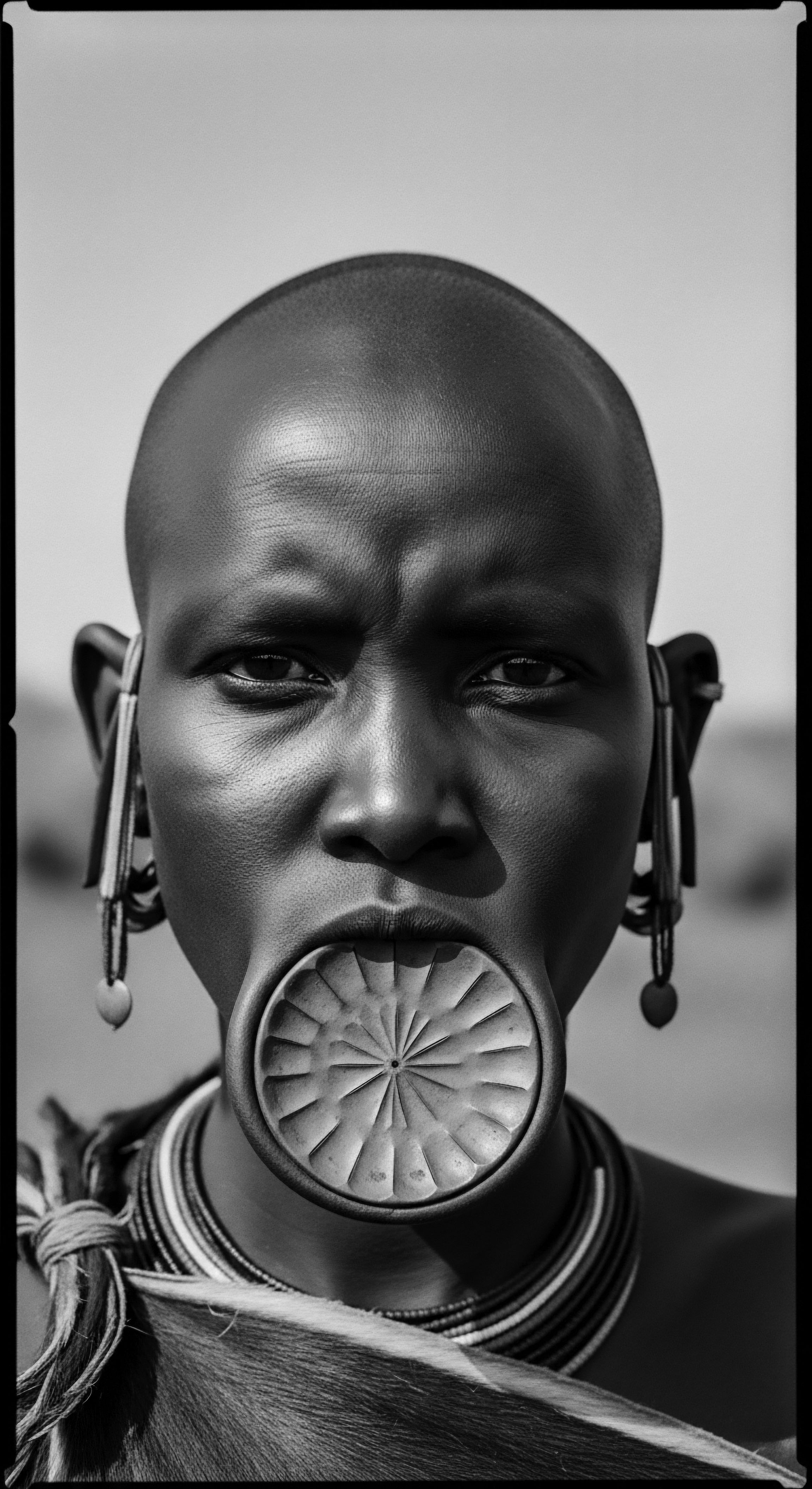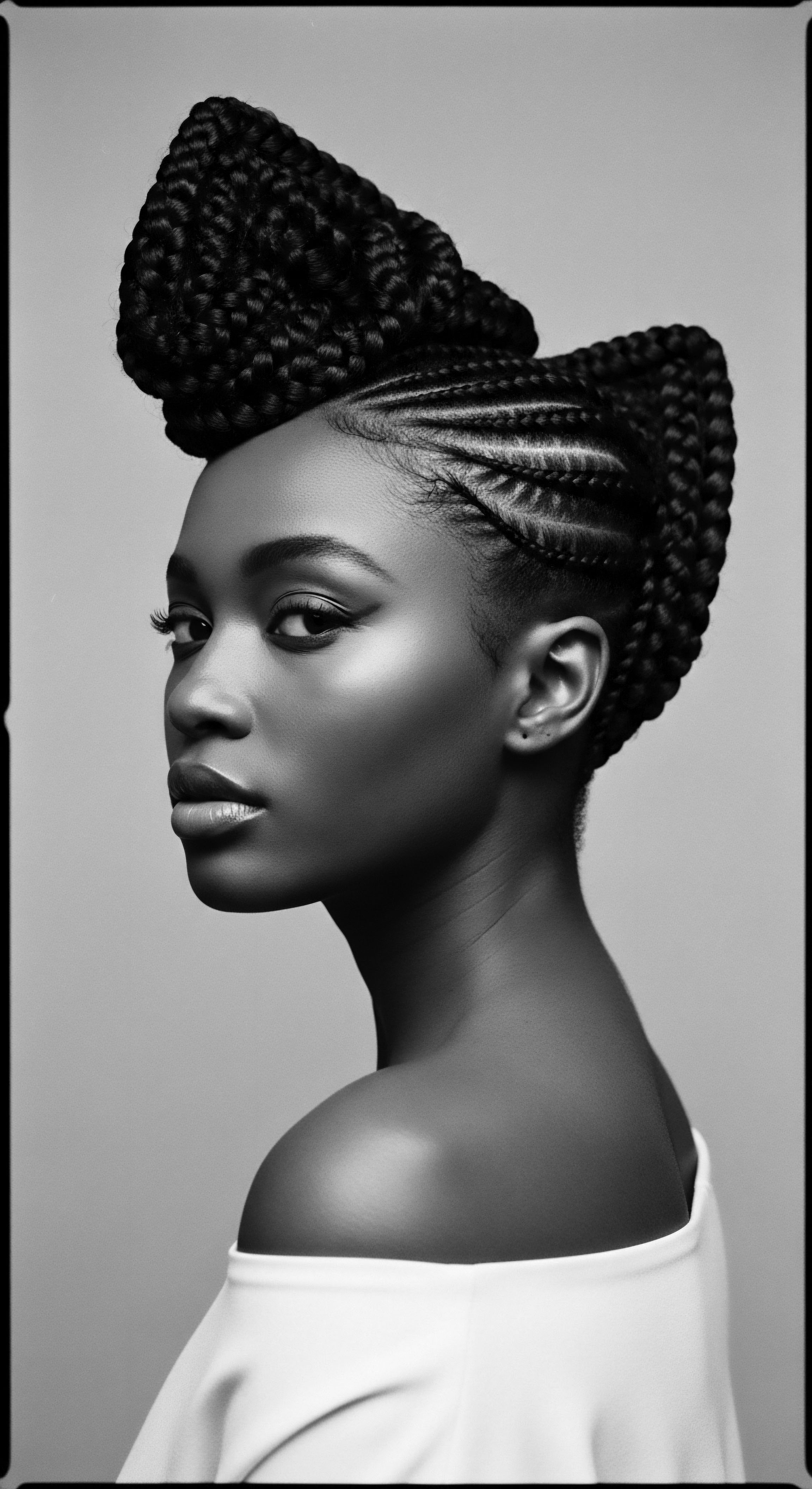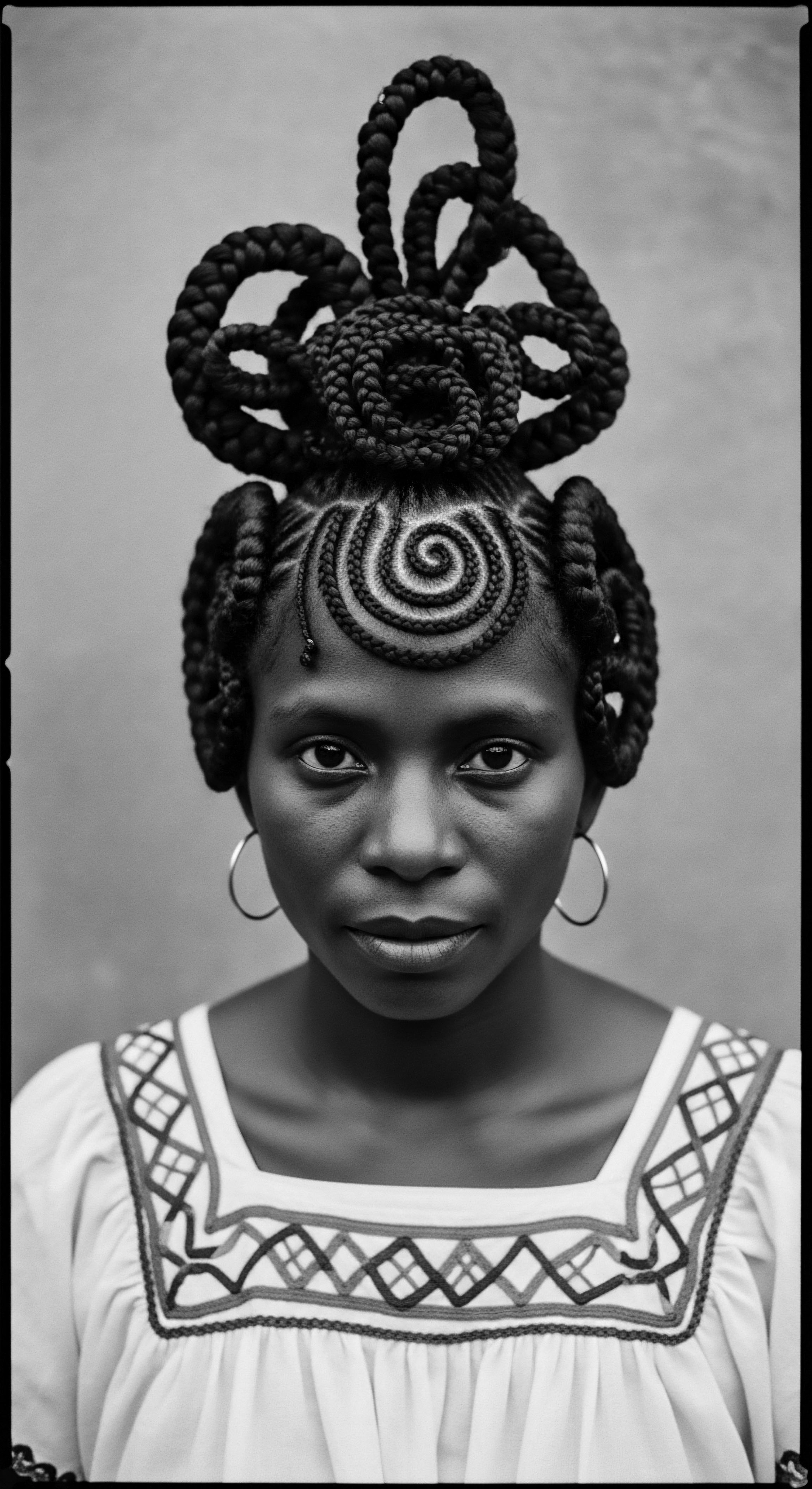
Fundamentals
The spirit of hair, an intricate crown that tells tales of lineage and survival, is deeply intertwined with the ancient wisdom passed through generations. Within this sacred connection, the concept of African Diasporic Ethnobotany emerges, offering a profound understanding of how plant life has historically sustained and adorned textured hair. It is not merely a scientific discipline, but a vibrant expression, a living archive of remedies and rituals that Black and mixed-race communities carried across continents and centuries. This foundational insight reveals how indigenous plant knowledge, rooted in the lands of Africa, adapted and flourished in new soils, shaping practices of care for hair as a tangible link to heritage.
At its core, the African Diasporic Ethnobotany is the study of the dynamic relationship between people of African descent, wherever they may reside across the globe, and the plants that have been instrumental in their cultural, spiritual, and physical well-being. Specifically for hair, this encompasses the ancestral wisdom of cultivating, preparing, and applying botanical elements for cleansing, conditioning, strengthening, and styling. This understanding extends beyond mere utility; it speaks to the intrinsic value placed on hair as a symbol of identity, community, and resilience, a truth often reflected in the plant-based traditions that sustained these connections.
The designation of African Diasporic Ethnobotany provides a clear framework for examining how forced migration and subsequent adaptation gave rise to novel botanical practices and the preservation of inherited knowledge. It acknowledges the ingenuity of individuals who, despite immense adversity, maintained their connection to the earth’s bounty and adapted these natural resources to nurture their textured hair. This deep connection served as a wellspring of comfort and an anchor to cultural memory.

The Seed of Understanding
Unpacking the meaning of African Diasporic Ethnobotany begins with recognizing the deep historical roots of plant knowledge in diverse African societies. Before the transatlantic slave trade, various African cultures possessed rich pharmacopoeias and sophisticated botanical systems for medicine, food, and personal care. These traditions were not static; they evolved over millennia, informed by observations of nature and passed down through oral histories and communal practices. The collective memory within these communities held the keys to unlocking the earth’s gifts.
When discussing its significance, we consider how African Diasporic Ethnobotany illuminates the pathways of plant knowledge. Enslaved Africans, forcibly removed from their homelands, carried not only their physical selves but also invaluable intellectual property, including a deep comprehension of plants and their multifarious uses. This botanical expertise, often hidden in plain sight, became a tool for survival and cultural continuity in unfamiliar landscapes.
African Diasporic Ethnobotany unveils the profound human-plant relationship nurtured by communities of African descent, illuminating ancestral hair traditions as a testament to enduring wisdom.

Initial Discoveries and Elemental Connections
- Botanical Legacy ❉ Exploring the specific plants and plant families native to Africa that have long been revered for their properties beneficial to hair and scalp health, such as those rich in mucilage or emollients.
- Ancestral Application ❉ Gaining insight into the simplest forms of plant use, from the direct application of plant saps to the creation of rudimentary infusions for hair cleansing and conditioning.
- Oral Transmission ❉ Recognizing that much of this wisdom was passed down through generations via storytelling, observation, and direct teaching within familial and communal circles, shaping the living heritage of hair care.

Intermediate
Moving beyond the foundational tenets, the African Diasporic Ethnobotany reveals itself as a complex, adaptive system, perpetually shaped by the currents of history and migration. The interpretation of this field at an intermediate level acknowledges the active agency of African peoples in transforming and preserving their plant-based knowledge, particularly as it pertains to the textured strands they carried with them. This is where the narrative shifts from mere identification to an appreciation of the sophisticated botanical adaptations that occurred across the diaspora.
The meaning of African Diasporic Ethnobotany at this stage delves into the mechanisms of cultural transference and botanical substitution. As African communities dispersed across the Americas and beyond, they encountered new environments with different flora. Their ancestral comprehension of plants allowed them to identify analogous species with similar properties, or to innovate entirely new applications for local vegetation. This continuous process of experimentation and adaptation underscores the dynamic and resilient nature of their ethnobotanical heritage.

The Living Memory of Greenery
The description of African Diasporic Ethnobotany at an intermediate level requires a deeper look into the ingenuity of botanical integration. It becomes apparent that African peoples, even in bondage, were active agents in the transatlantic exchange of plants and plant knowledge. They brought with them seeds, root cuttings, and invaluable information, establishing what Judith Carney termed “Botanical Gardens of the Dispossessed” (Carney, 2012). These clandestine gardens often contained African food crops, but also plants for medicinal and cosmetic applications, including those essential for hair health.
The significance of this cross-cultural botanical exchange is profound for textured hair. Traditional African ingredients like shea butter (from the Vitellaria paradoxa tree), often used for its emollient properties, or black soap (derived from plantain skins and other ashes), recognized for its cleansing power, journeyed with enslaved Africans. In new lands, where these exact species might not have grown, communities sought out and incorporated local alternatives like coconut oil, avocado, or aloe vera, applying inherited knowledge to new botanical contexts.
Diasporic ethnobotany represents a living legacy of botanical adaptation, where ancestral plant knowledge was creatively reinterpreted to sustain hair health in new lands.

Adaptation and Innovation in Hair Care Traditions
The elucidation of how traditional practices adapted in the diaspora is crucial. Consider the meticulous preparation of hair oils and masks. In Africa, specific plant parts, often roasted and ground, were infused into oils or butters to create potent conditioners.
This methodology, this deeply ingrained practice, was transferred, even if the specific plants changed. The very act of crafting these preparations became a communal endeavor, solidifying bonds and transmitting cultural meaning alongside botanical knowledge.
One potent example of this enduring heritage is the traditional use of Chebe powder by the Basara Arab women of Chad. This historical practice, deeply rooted in their cultural identity, involves a unique blend of roasted and ground ingredients, primarily from the Croton Zambesicus plant, alongside other botanicals like mahllaba soubiane seeds, cloves, resin, and missic stone. The Basara women have, for generations, applied this mixture to their hair, avoiding the scalp, and credit it for their exceptionally long, strong, and healthy hair, often extending past their waist. The traditional application method often involves mixing the powder with oils or butters, applying it to damp, sectioned hair, and then braiding or twisting it into protective styles for days.
This continuous practice highlights the power of consistent, plant-based care for length retention by reducing breakage and improving elasticity, particularly for coily hair textures. The passing down of this method through rituals deeply rooted in community, beauty, and culture underscores its significance as a symbol of identity and pride, demonstrating the sustained power of ancestral knowledge in preserving hair health and length.
| Plant Name / Traditional Source Shea Butter ( Vitellaria paradoxa ) |
| Primary Benefit (Ancestral Understanding) Moisturizing, softening, protective sealant for hair strands. |
| Diasporic Adaptation / Equivalent Widely adopted in the diaspora; often combined with local oils like coconut or olive. |
| Plant Name / Traditional Source Black Soap (from plantain ashes, shea, palm oil) |
| Primary Benefit (Ancestral Understanding) Gentle cleansing, scalp purification, removing impurities. |
| Diasporic Adaptation / Equivalent Ingredients adapted based on regional availability; often combined with infusions of local herbs. |
| Plant Name / Traditional Source Chebe Powder ( Croton zambesicus, Chad) |
| Primary Benefit (Ancestral Understanding) Length retention, strengthening, reducing breakage for coily hair. |
| Diasporic Adaptation / Equivalent Its principles of sealing moisture adopted by many in the diaspora, sometimes with locally sourced plant-based ingredients or oils. |
| Plant Name / Traditional Source Aloe Vera ( Aloe barbadensis miller ) |
| Primary Benefit (Ancestral Understanding) Soothing scalp, conditioning, detangling, promoting softness. |
| Diasporic Adaptation / Equivalent Indigenous to Africa, widely cultivated and used across the Caribbean and Americas for hair. |
| Plant Name / Traditional Source This table illustrates the enduring legacy of African botanical wisdom and its remarkable adaptability in new environments, emphasizing the continuity of care. |

Academic
The academic elucidation of African Diasporic Ethnobotany calls for a rigorous and interdisciplinary examination, transcending a superficial understanding to grasp the intricate systems of knowledge, practice, and socio-cultural resistance embedded within. It represents a scholarly pursuit to understand the complex interplay between human populations of African descent, their displacement, and the botanical world they continually engaged with to sustain life, culture, and particularly, their hair heritage. This academic meaning necessitates a multi-layered analysis of botanical transfer, indigenous knowledge retention, and cultural adaptation in the face of profound historical rupture.
This delineation is more than a descriptive account; it is an analytical framework that unpacks the mechanisms through which traditional African plant knowledge survived and transformed across vast geographical and temporal expanses. Researchers in this domain explore not just what plants were used, but how this knowledge was transmitted (often orally, through ritual, or through generational observation), why specific plants were prioritized, and the socio-political implications of maintaining these botanical connections. It casts a discerning eye upon the colonial suppression of indigenous practices and the resilience of African diasporic communities in safeguarding their botanical heritage for textured hair and holistic well-being.

A Confluence of Botanical Wisdom and Historical Agency
From an academic perspective, the African Diasporic Ethnobotany challenges conventional narratives that often overlook the profound agency of enslaved Africans as botanical innovators and cultivators. Robert Voeks and John Rashford, in their seminal work African Ethnobotany in the Americas, present a comprehensive examination of how African knowledge systems of plants—for food, medicine, and fiber—were not lost but actively transferred and adapted in the New World. This scholarly contribution underscores that Africans were not merely laborers in a new agricultural system but active agents in shaping the floristic landscape of the Americas, establishing what some scholars refer to as “Botanical Gardens of the Dispossessed” where African and New World plants coexisted and were integrated into complex systems of care.
Consider the enduring relevance of African Diasporic Ethnobotany for textured hair heritage. The biophysical characteristics of coily hair, its unique density, porosity, and tendency towards dryness, demanded specific care that often diverged from European hair care norms. African ancestral practices, deeply attuned to these needs, employed plants rich in mucilages, saponins, and fatty acids to provide hydration, cleansing, and conditioning.
The academic inquiry into this domain involves identifying the phytochemical properties of these plants and understanding how traditional methods of preparation maximized their efficacy for hair health. For instance, the use of Lawsonia inermis (henna) or Indigofera tinctoria (indigo) not only offered coloring agents but also conditioning benefits, a holistic approach that modern science is only beginning to fully appreciate.
Academic inquiry into African Diasporic Ethnobotany unveils the sophisticated botanical knowledge and resilient cultural practices that preserved textured hair heritage despite historical dispossessions.

The Unbroken Lineage of Hair Knowledge ❉ A Case Study of Chebe
A powerful illustration of African Diasporic Ethnobotany’s enduring legacy is found in the traditional hair care regimen of the Basara women of Chad. Their consistent use of Chebe powder, derived predominantly from Croton Zambesicus, provides a compelling case study of how deeply ingrained ancestral botanical practices contribute to remarkable hair health and length retention. This practice, often involving an intricate layering of powdered plant material infused with oils, acts as a protective barrier around the hair shaft, significantly reducing breakage and promoting length retention over time.
From an academic lens, the Chebe tradition signifies more than a beauty secret; it exemplifies a profound understanding of plant biochemistry and hair structure that predates modern trichology. The combination of ingredients in Chebe powder, including the mucilage-rich qualities of some components and the strengthening properties of others, works synergistically. The application method, which coats the hair rather than the scalp, addresses the unique susceptibility of coily hair to moisture loss and mechanical damage, effectively creating a natural sealant that minimizes friction and environmental stress.
The practice’s consistent, ritualistic nature within the Basara community speaks to its cultural entrenchment and the efficacy observed over generations. This serves as a vital example for current scientific exploration into botanical solutions for textured hair, suggesting that traditional wisdom often holds empirical truths awaiting contemporary validation.
The academic definition of African Diasporic Ethnobotany compels researchers to consider the subtle yet profound mechanisms through which traditional knowledge systems persist. It examines the socio-economic factors that have both challenged and sustained these practices, from the scarcity of traditional ingredients in new lands to the vibrant communal networks that ensured knowledge continuity. It also explores how contemporary interest in natural hair movements within the diaspora represents a reclamation of this ancestral botanical heritage, a conscious decision to reconnect with practices that honor the unique biology and cultural history of textured hair. This scholarly lens not only validates ancient wisdom but also informs sustainable approaches to modern hair care, ensuring that the legacy of botanical knowledge continues to nourish future generations.
- Botanical Migration and Adaptation ❉ Investigate the specific pathways of plant transfer from Africa to the Americas and the Caribbean, examining both intentional introductions and the adaptive use of new world flora that functionally mirrored African botanical counterparts.
- Ethnomedical and Cosmetological Continuity ❉ Analyze the consistent application of African ethnobotanical principles for medicinal and hair care purposes, even with plant substitutions, highlighting the enduring philosophy of holistic well-being.
- Cultural Resilience and Identity Markers ❉ Explore how the practice of plant-based hair care acted as a powerful act of cultural preservation and resistance, allowing communities to maintain distinct identities amidst oppressive systems.
- Modern Reappraisal and Validation ❉ Examine the contemporary resurgence of interest in African diasporic hair care practices, including scientific validation of their efficacy and the ethical implications of commercializing ancestral knowledge.

Reflection on the Heritage of African Diasporic Ethnobotany
To truly appreciate African Diasporic Ethnobotany is to embark on a profound meditation upon textured hair, its enduring heritage, and the meticulous care it has received through generations. This exploration transcends mere historical fact, reaching into the soulful depths of identity and communal memory. The ancestral wisdom, echoing from the sun-kissed lands of Africa, has woven itself into the very fabric of diasporic life, asserting a continuous, vibrant connection to the earth’s nurturing embrace.
The threads of this botanical understanding span the vast oceans, settling in new landscapes yet retaining their inherent resilience. We perceive the whispers of grandmothers carefully selecting herbs, the gentle rhythm of hands preparing concoctions, and the quiet strength found in communal styling rituals. These practices, grounded in deep ethnobotanical comprehension, became more than routines; they blossomed into acts of self-preservation and expressions of profound cultural pride. Hair, cared for with the earth’s bounty, became a vibrant symbol of continuity, a defiant declaration of spirit against forces seeking to diminish it.
The journey from elemental biology to the nuanced artistry of hair care mirrors the odyssey of African diasporic communities themselves. From the earliest moments of forced transit, plant knowledge was a lifeline—a source of sustenance, healing, and the means to tend to one’s self. The meticulous transfer of plant insights, whether through smuggled seeds or embodied memory, allowed for the re-establishment of familiar comforts and the creation of new traditions. This unbroken chain of knowledge, often hidden in plain sight, continued to shape how textured hair was perceived, treated, and celebrated.
Today, as awareness of African Diasporic Ethnobotany grows, we witness a beautiful convergence ❉ modern science affirming ancestral truths, and contemporary wellness practices re-centering traditional wisdom. The resurgence of interest in natural hair care, rooted in the desire for authenticity and health, is a powerful testament to the enduring power of this heritage. It is a re-embracing of what was always known ❉ that the path to vibrant hair health often lies in the tender embrace of nature, guided by the profound wisdom of those who came before. This heritage provides a compass, guiding us toward a future where textured hair is universally recognized not only for its inherent beauty but also for the rich, living stories it carries within each coil and curl.

References
- Carney, Judith A. Black Rice ❉ The African Origins of Rice Cultivation in the Americas. Harvard University Press, 2012.
- Mouchane, Mohamed, et al. “Ethnobotanical Survey of Medicinal Plants used in the Treatment and Care of Hair in Karia ba Mohamed (Northern Morocco).” Journal of Medicinal Plants and By-products, vol. 13, no. 1, 2023, pp. 201-208.
- Voeks, Robert A. and John F. Rashford, editors. African Ethnobotany in the Americas. Springer, 2013.
